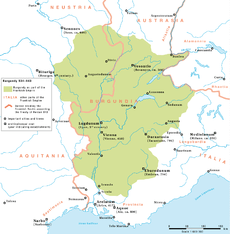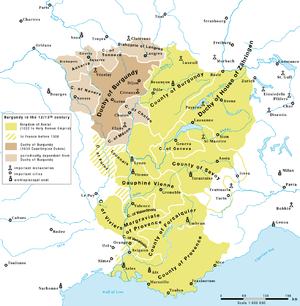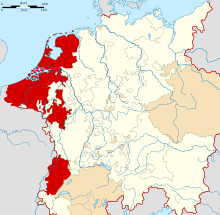Kingdom of Burgundy
Kingdom of Burgundy was a name given to various states located in Western Europe during the Middle Ages. The historical Burgundy correlates with the border area of France, Italy and Switzerland and includes the major modern cities of Geneva and Lyon.
As a political entity, Burgundy existed in a number of forms with different boundaries, notably, when it was divided into Upper and Lower Burgundy and Provence. Two of the entities, the first around the 6th century and the second around the 11th century, were called the Kingdom of Burgundy. At other times were the Kingdom of Provence, the Duchy of Burgundy and the County of Burgundy.





Kingdom of the Burgundians (4th century – 534 AD)
Burgundy is named after a Germanic tribe of Burgundians who originated in mainland Scandinavia, then settled on the island of Bornholm, whose name in Old Norse was Burgundarholmr ("Island of the Burgundians"). From there they migrated south through Germanic lands into Roman Gaul and settled in the western part of the Alps and Rhône valley, establishing a barbarian kingdom of the Burgundians.
The first documented, though not historically verified King of the Burgundians was Gjúki (Gebicca), who lived in the late 4th century. In the course of the Crossing of the Rhine in 406 the Burgundians settled as foederati in the Roman province of Germania Secunda along the Middle Rhine. Their situation worsened when about 430 their king Gunther started several invasions into neighbouring Gallia Belgica, which led to a crushing defeat by joined Roman and Hunnic troops under Flavius Aetius in 436 near Worms (the focus of the mediæval Nibelungenlied poem).
The remaining Burgundians from 443 onwards settled in the Sapaudia (i.e. Savoy) region, again as foederati in the Roman Maxima Sequanorum province. Their efforts to enlarge their kingdom down the Rhône river brought them into conflict with the Visigothic Kingdom in the south. After the fall of the Western Roman Empire in 476, king Gundobad allied with the powerful Frank king Clovis I against the threat of Theoderic the Great. He was then able to organize the Burgundian acquisitions based on the Lex Burgundionum, an Early Germanic law code.
The decline of the Kingdom began when they came under attack from their former Frank allies. In 523 the sons of Clovis I campaigned in the Burgundian lands, instigated by their mother Clotilde, whose father king Chilperic II of Burgundy had been killed by Gundobad. In 532 the Burgundians were decisively defeated by the Franks at Autun, whereafter king Godomar was killed and Burgundian lands was annexed by the Frankish Empire in 534.
Frankish Burgundy, 534–933
While there no longer was an independent Burgundian kingdom, between 561 and 584 and between 639 and 737 several rulers of the Frankish Merovingian dynasty used the title of "King of Burgundy".
Kingdom of Provence, 855–863
Partitions of Charlemagne's empire by his immediate Carolingian heirs led to a short-lived kingdom of Middle Francia, which was created after the 843 Treaty of Verdun. It included lands from North Sea to southern Italy and was ruled by emperor Lothair I. The northwestern part of the former Burgundian lands as Duchy of Burgundy (Bourgogne) was included in the kingdom of West Francia. Shortly before his death in 855, Lothair I divided his kingdom among his three sons in three parts - Lotharingia, Kingdom of Italy and regions of Lower Burgundy and Provence which were left to the youngest son - Charles of Provence. This partition created more conflicts, as older Carolingians who ruled West Francia and East Francia viewed themselves as the true heirs of Middle Francia.
As Charles of Provence was too young to rule, the actual power was held by regent, count Girart II of Vienne whose wife was the sister-in-law of emperor Lothar I. Girart was a strong regent, defending the kingdom from Vikings, who raided as far as Valence. Charles' uncle, Charles the Bald of West Francia, attempted to intervene in Provence in 861 after receiving an appeal for intervention from the Count of Arles. He invaded Provence as far as Mâcon before being restrained by Hincmar of Rheims.
Upper and Lower Burgundy, 879–933
In 858, Count Girart arranged that should Charles of Provence die without heirs, the Kingdom of Provence would revert to Charles' older brother Lothair II who ruled in Lotharingia. When Charles died in 863, his oldest brother Louis II claimed Provence for himself, so the kingdom was divided between the two remaining brothers: Lothair II received the bishoprics of Lyon, Vienne and Grenoble, to be governed by Girart; and Louis II received Arles, Aix-en-provence and Embrun.
After the death of Lothair II, the 870 Treaty of Meerssen allotted the northern part of former Middle Francia to King Louis the German of East Francia and the southern lands of Charles of Provence to King Charles the Bald of West Francia.
After the overthrow of Charles the Bald in 877, followed by the death of his incapable son Louis the Stammerer two years later, the Frankish noble Boso of Provence proclaimed himself a "King of Burgundy and Provence" at Vienne in 879 and established his kingdom of Lower Burgundy and Provence.
Upper Burgundy remained under the influence of the East Frankish king Charles the Fat. It was centered in what is now western Switzerland, and included some neighboring territories now in France and Italy and some which later became the Franche-Comté. From 887 these northern territories formed the Kingdom of Upper Burgundy, proclaimed by the Welf noble Rudolph I of Burgundy at Saint-Maurice, Switzerland.
Kingdom of Arles, 933–1378
The ruler of Upper Burgundy, Rudolph II, acquired Lower Burgundy from Hugh of Arles in 933 and created a kingdom which was known as the Kingdom of Arles. The Kingdom existed independently until 1033, when it was absorbed into the Holy Roman Empire under Conrad II. It was one of the three kingdoms within the medieval Empire, along with the Kingdom of Germany and the Kingdom of Italy.
The kingdom gradually fragmented as it was divided among heirs, or territories were lost and acquired through diplomacy and dynastic marriages.
By 1378, when the Kingdom of Arles ceased to exist, large parts were already held by the County of Savoy. The remaining lands were ceded to the Dauphin of France Charles VI by Emperor Charles IV, creating the Dauphiné.
"Third Kingdom of Burgundy"
In the late 15th century Duke Charles the Bold conceived the project of combining his territories into a "Third Kingdom of Burgundy" with himself as its fully independent monarch. Charles even persuaded Emperor Frederick III to crown him as a king at Trier. The planned ceremony did not take place because the emperor fled during the night of September 1473, due to displeasure with the duke's attitude. The duchy ultimately ended as an independent realm with the defeat and mutilation of Charles at the Battle of Nancy.
See also
Sources
- Cope, Christopher (1987). Phoenix Frustrated: The Lost Kingdom of Burgundy. Constable.CS1 maint: ref=harv (link)
- Davies, Norman (2011). Vanished Kingdoms: The History of Half-Forgotten Europe. Penguin.CS1 maint: ref=harv (link)
- Fournier, Paul (1885). Le royaume d'Arles et de Vienne sous le règne de Frédéric II (1214–1250). Grenoble: G. Dupont.CS1 maint: ref=harv (link)
- Fournier, Paul (1891). Le royaume d'Arles et de Vienne (1138–1378): étude sur la formation territoriale de la France dans l'Ést et le Sudest. Paris: Picard.CS1 maint: ref=harv (link)
- Fournier, Paul (1959). "The Kingdom of Burgundy or Arles from the Eleventh to the Fifteenth Century". In C. W. Previté-Orton (ed.). The Cambridge Medieval History, VIII: The Close of the Middle Ages. Cambridge: Cambridge University Press. pp. 306–31.CS1 maint: ref=harv (link)
- Poole, Reginald (1911). "Burgundian Notes, I: The Alpine Son-in-Law of Edward the Elder". English Historical Review. 26 (102): 310–17. doi:10.1093/ehr/xxvi.cii.310.CS1 maint: ref=harv (link)
- Poole, Reginald (1912). "Burgundian Notes, II: Cisalpinus and Constantinus". English Historical Review. 27 (106): 299–309. doi:10.1093/ehr/xxvii.cvi.299.CS1 maint: ref=harv (link)
- Poole, Reginald (1913). "Burgundian Notes, III: The Union of the Two Kingdoms of Burgundy". English Historical Review. 28 (109): 106–12.CS1 maint: ref=harv (link)
- Poole, Reginald (1915). "Burgundian Notes, IV: The Supposed Origin of Burgundia Minor". English Historical Review. 30 (117): 51–56. doi:10.1093/ehr/xxx.cxvii.51.CS1 maint: ref=harv (link)
- Poupardin, René (1899). Boson et le royaume de Provence (855–933). Chalon-sur-Saône: E. Bertrand.CS1 maint: ref=harv (link)
- Poupardin, René (1901). Le Royaume de Provence sous les Carolingiens, 855–933. Paris: Émile Bouillon.CS1 maint: ref=harv (link)
- Poupardin, René (1907). Le Royaume de Bourgogne, 888–1038: étude sur les origines du royaume d'Arles. Paris: Champion.CS1 maint: ref=harv (link)
- Wilson, Peter (2016). Heart of Europe: A History of the Holy Roman Empire. Cambridge, MA: Belknap Press.CS1 maint: ref=harv (link)
